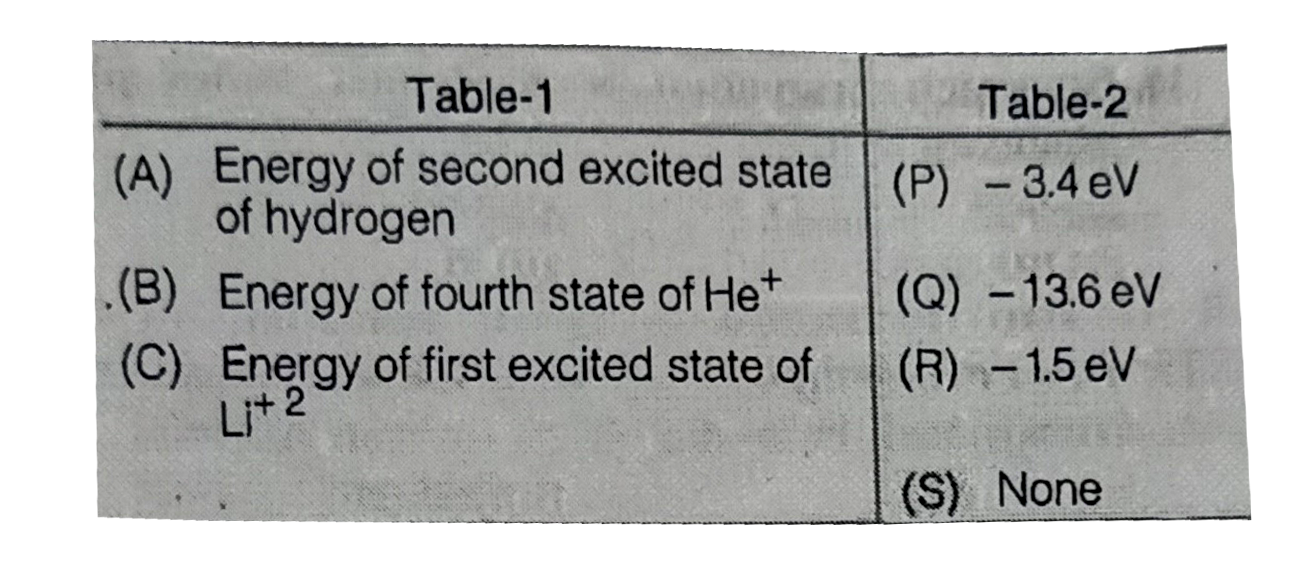If I exciation energy for the H-like (hypothetical) sample is 24 eV, then binding energy in III excited state is :
(a)2eV
(b)3eV
(c)4eV
(d)5eV
2 eV
3 eV
4 eV
5 eV
The correct Answer is:A
To find the binding energy in the third excited state of a hydrogen-like atom given the excitation energy of 24 eV, we can follow these steps:
1. Understand the Binding Energy Formula:
The binding energy (BE) for a hydrogen-like atom can be expressed as:
BE=−13.6Z2n2 eV
where Z is the atomic number and n is the principal quantum number.
2. Identify the Excitation Energy:
The excitation energy given is 24 eV. This is the energy required to move from the ground state (n=1) to the first excited state (n=2).
3. Relate Excitation Energy to Binding Energy:
The excitation energy can be expressed in terms of the binding energies of the two states:
Eexcitation=BE(n=1)−BE(n=2)
Substituting the binding energy formula:
24=(−13.6Z212)−(−13.6Z222)
Simplifying gives:
24=−13.6Z2(1−14)=−13.6Z2(34)
4. Solve for Ionization Energy:
Rearranging the equation:
24=−13.6Z2⋅34
Multiplying both sides by -4/3:
−32=13.6Z2
Thus, we find:
Z2=3213.6≈2.35
5. Calculate Ionization Energy:
The ionization energy (IE) for the first excited state (n=2) can be calculated as:
IE=−BE(n=2)=13.6Z222=13.6⋅2.354≈8 eV
6. Find Binding Energy in the Third Excited State:
The third excited state corresponds to n=4:
BE(n=4)=−13.6Z242=−13.6⋅2.3516≈−2.0 eV
Therefore, the binding energy is:
BE(n=4)=2 eV
Final Answer:
The binding energy in the third excited state is 2 eV (Option a).
The binding energy (BE) for a hydrogen-like atom can be expressed as:
BE=−13.6Z2n2 eV
where Z is the atomic number and n is the principal quantum number.
The excitation energy given is 24 eV. This is the energy required to move from the ground state (n=1) to the first excited state (n=2).
The excitation energy can be expressed in terms of the binding energies of the two states:
Eexcitation=BE(n=1)−BE(n=2)
Substituting the binding energy formula:
24=(−13.6Z212)−(−13.6Z222)
Simplifying gives:
24=−13.6Z2(1−14)=−13.6Z2(34)
Rearranging the equation:
24=−13.6Z2⋅34
Multiplying both sides by -4/3:
−32=13.6Z2
Thus, we find:
Z2=3213.6≈2.35
The ionization energy (IE) for the first excited state (n=2) can be calculated as:
IE=−BE(n=2)=13.6Z222=13.6⋅2.354≈8 eV
The third excited state corresponds to n=4:
BE(n=4)=−13.6Z242=−13.6⋅2.3516≈−2.0 eV
Therefore, the binding energy is:
BE(n=4)=2 eV
The binding energy in the third excited state is 2 eV (Option a).
Topper's Solved these Questions
- BOOK - NARENDRA AWASTHI ENGLISHCHAPTER - ATOMIC STUCTUREEXERCISE - Level 3 (Passage 1)3videos
ATOMIC STUCTURE
- BOOK - NARENDRA AWASTHI ENGLISHCHAPTER - ATOMIC STUCTUREEXERCISE - Level 3 (Passage 2)4videos
ATOMIC STUCTURE
- BOOK - NARENDRA AWASTHI ENGLISHCHAPTER - ATOMIC STUCTUREEXERCISE - Subjective problems1videos
ATOMIC STUCTURE
- BOOK - NARENDRA AWASTHI ENGLISHCHAPTER - CHEMICAL EQUILIBRIUMEXERCISE - Match the column1videos
CHEMICAL EQUILIBRIUM
Similar Questions
Knowledge Check
- Question 1 - Select One or More
Energy of H-atom in the ground state is -13.6 eV, hence energy in the second excited state is
A−6.8eVB−3.4eVC−1.51eVD−4.53eV
If the ionization energy of He+ is 54.4 eV then
View SolutionIn a hydrogen atom, if energy of an electron in ground state is −13.6eV, then that in the 2nd excited state is :
View SolutionThe ionization energy for the hydrogen atom is 13.6eV then calculate the required energy in eV to excite it from the ground state to 1st excited state.
View SolutionThe energy of the electron in the ground state of H-atom is −13.6eV. The energy of the first excited state will be
View SolutionExcitations energy of hydrogen atom is 13.6eV match the following
 View Solution
View SolutionThe ground state energy of hydrogen atom is −13.6eV. The energy of second excited state of He+ ion in eV is
View SolutionIn a hydrogen atom , If the energy of electron in the ground state is -x eV ., then that in the 2nd excited state of He+ is
View Solution

